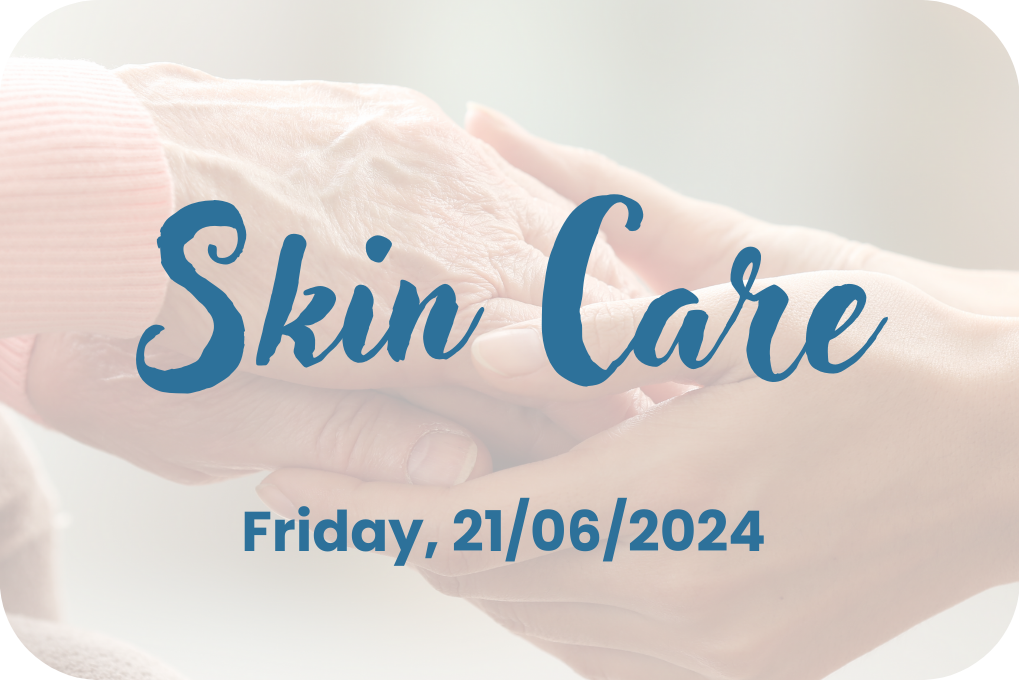Skin Care

This article was part of our series for World Continence Week 2024.
The previous 4 articles have each looked at incontinence from different points of view: from the symptoms and basics of incontinence, through diet, fluid management and medication to the effects incontinence has on the psyche and the effects dementia has on incontinence. Now, for the last article this week, we will focus on another area affected by incontinence: the skin.
What does incontinence have to do with Skin Care?
Our skin is incredible. Layers upon layers of protection from anything ranging from dirt and cuts to UV-radiation, to say nothing of the other jobs it fulfills (like temperature regulation through sweat in summer and fat cells in winter). However, our skin is not invulnerable, and it is also not eternal.
As we age, the skin deteriorates, loses much of its elasticity and ability to retain moisture. This means it gets drier and so more vulnerable to injuries and infection. And this is where so-called moisture-associated skin damage comes in.
Have you ever stayed in the shower, bath, or pool for too long? Eventually, the hands and feet get bloated and wrinkly. That’s because our skin can keep outside influences out, but not forever. And now imagine if that moisture isn’t clean water, but other substances. Get the picture?
Incontinence Associated Dermatitis (IAD)
That’s how IAD develops. If you (or a loved one) are incontinent, that means you are at a higher risk than other people for your skin to regularly come into contact with urine or faeces. If this happens frequently enough or over a prolonged period of time, you are at high risk for IAD (and other kinds of moisture-associated skin damage in general, but let’s stay with IAD for now). This counts double if you have faecal incontinence, because faeces are an even greater irritant than urine is. IAD essentially means that the skin gets inflamed because of this exposure, which increases the risk of infections and general deterioration of the skin (since this used to happen often when people wore wet or inferior continence aids for too long, this was also referred to as ‘nappy rash’).
IAD can occur in any area exposed to the irritants, anywhere from in the groin and buttocks down the upper thigh and up the lower back. If you see persistent redness and feel pain, burning or itching – that’s probably IAD. Worth noting here that especially bedridden individuals are at risk of pressure injuries which can look similar to IAD, so always make sure to consult the GP (or treating team in a hospital/aged care home).
Managing IAD
Although it would be best to just prevent IAD, what do we do when it is already there?
First things first, before fixing what is there, the source needs to be gone. This means identifying why IAD could develop. Are the continence aids not absorbent enough so they overflow or leave urine/faeces on the skin? Has the area not been properly cleaned after the last episode of incontinence? These could lead to IAD developing.
Fixing the issue is usually beyond the layman. A trip to the doctor is most likely in order here. Additionally, there are a few measures that can help (but none of these replace a professional assessment, so always consult with your doctor):
- Clean the area properly after every episode with soap-free pH-adjusted cleansers (this is especially true for faecal incontinence).
- Pat the skin dry instead of rubbing (rubbing just agitates the skin more).
- Use skin barrier creams to protect the skin and, on dry skin, moisturisers to restore the barrier function of the skin.
- Use continence aids that fit well, remove moisture from the skin quickly, and are absorbent enough for your needs (change the aids after episodes of faecal incontinence, FI usually has too much solid matter to remove it all from the skin no matter how absorbent).
Preventing IAD
Now, assuming we fixed the issue or IAD has not occurred yet, how do we prevent it in the future?
The main decree here is constant vigilance. You are already one step ahead, because you now know that IAD exists and how it can be caused, so you know what to look out for. In addition, as per the Clinical Excellence Commission of NSW, these are the three main points of prevention:
- Manage Incontinence. Treat reversible causes, make toilet use easy and assist/seek assistance to reduce the number of incontinent episodes.
- Introduce Skin Care Regimen. Gently but thoroughly clean the skin after every episode, use protectants to restore/maintain the barrier function of the skin.
- Utilise Correct Aids. Use continence aids with moisture-wicking function and super-absorbent polymers & do not stack multiple layers (which increases heat, friction, moisture, and prevents airflow).
The last point above is also why the Valui range includes our so-called moisture highway: to wick away moisture from the skin quickly and efficiently, to reduce the chance of IAD and similar conditions developing. Following these recommendations (and the ones mentioned above), hopefully you can prevent IAD from developing on yourself or your loved ones, or know what to do when it shows up. By being informed, incontinence (and assorted conditions) become less of a bogeyman and more of what it is: a condition that can be understood, managed, and in some cases treated and reversed.